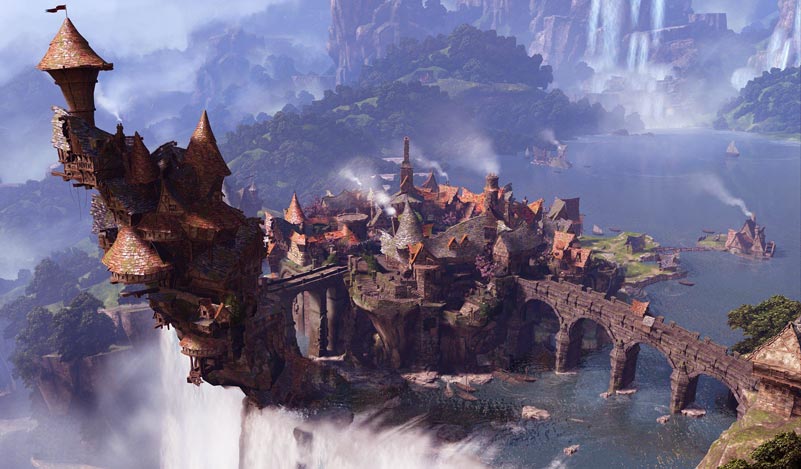
RPGs are some of the most polarizing video games out there, with different groups either loving them or hating them. You need to be in a certain mindset to play an RPG, and it takes a lot more investment than an action game or sports game. However, the very idea of what an RPG is can be debated, and fans of one type might hate another type. This is where the separation between the East (Japan) and the West (America and Europe) comes in, and how the big wall between the two cultures’ approaches to RPGs has effectively made two completely different genres.
To put it simply, western RPGs craft a world, while eastern RPGs craft a story. Yes, the former have stories and the latter have worlds, but the emphasis on each is clear. Western RPGs put the player in control of the game and let them write their own story, following the signposts left for them. Eastern RPGs make the player a part of the story and let them explore the world in the way that lets that story unfold.
Skyrim is the best example of this, but all three of the major western RPG series (Elder Scrolls, Baldur’s Gate/D&D variants, and Ultima) share this. They put you in a big world and let you decide how you want to go through it. They might give you specific objectives and let you play an epic quest to save the world, but they still leave you almost untouched in a setting where you can go anywhere. The Elder Scrolls games are particularly infamous for this: they let you start as a prisoner who’s just been given freedom and a mission. The mission is usually a weak and uninteresting one, tied into the main plot that doesn’t outshine the many side quests available. There’s a story to go through, but you might not even notice it when you’re so busy seeing what you can do and what quests you can find.
Compare this with Final Fantasy, which always leads you through a set plot of varying linearity. You might be able to explore a little and find side quests like in Final Fantasy 6, or you might just have to run through a bunch of corridors like in Final Fantasy 13, but in all of those cases you’re dropped into the shoes of named characters in a specific party and have to take specific paths to advance in the game. It takes you through the story, focusing on the epic quest you’re on with side quests kept to the side.
Both approaches work well, and both approaches have their problems. For all I complained about Final Fantasy 13 for being linear and jargon-heavy, it did have a complex story that had a lot at stake and explored the idea of destiny in a thoughtful way. And for all I love the Elder Scrolls games, they are buggy to a fault and the “main quest” of the games always fall to the wayside of the interesting quests you can do for the different factions and guilds. There isn’t a better RPG between the two, because they each do certain things great and screw up certain things horribly. They very literally are two different genres.
Quick question: name the main big bad of Oblivion. Follow-up question: Name a memorable random or otherwise not-part-of-the-story scenario in Final Fantasy 7. Both questions are difficult to answer, but if you reversed the games, you’ll get very fast responses (Sephiroth/Jenova and any of the higher Dark Brotherhood or Thieves Guild quests).
The emphasis and focus of the two games are sadly mutually exclusive, though each has come close to a firm grip on the other’s advantages. Morrowind’s main plot line was fairly epic, with gods, legendary tools, a prophecy that actually tied into the player’s life and the plot, and a huge mountain of doom and corpses. Final Fantasy 6 had tons of optional quests, especially in the World of Ruin, where you could seek out each of your party members and then find their best weapon/magic/closure to their storylines. Unfortunately, as close as adventure and story can come, there’s still a pretty big wall, and that wall is interactivity.
With few exceptions, outside of the difference between emphasis on storyline and open-ended questing, the big distinction between eastern and western RPGs is what you can physically do. If you can pick up an item in a Japanese RPG, it is going to be useful, eithe ras part of a quest or during battle. If you can pick up an item in a western RPG, it might just be a flavor object, something you can toss around or arrange nicely on furniture. The eastern RPG designs interactive elements that can relate directly to the game’s story, quests, or gameplay. The western RPG adds tons of otherwise useless objects to provide a sense of immersiveness and interactivity. Again, one is telling a story, and the other is building a world to explore.
What’s your favorite type of RPG? What calls out to you? Japanese RPGs used to be my bread and butter, but I’ve developed a strong love for western RPGs ever since Morrowind. The freedom is more fun than the plot when I play, and western RPGs offer more of a real sense of adventure, instead of a specific quest. Tell us what you look for in an RPG below.
